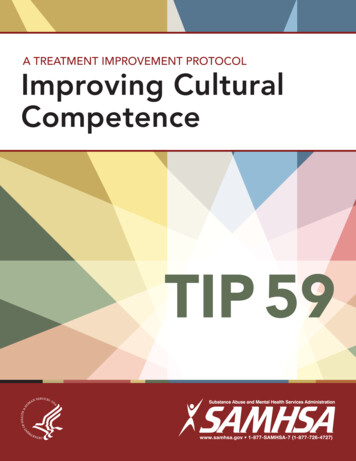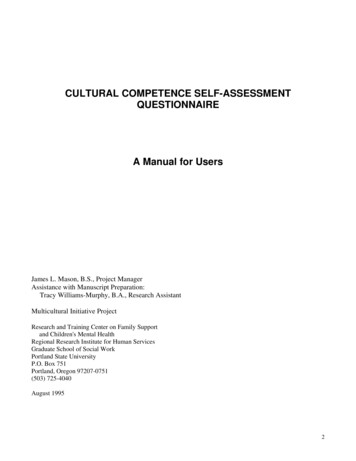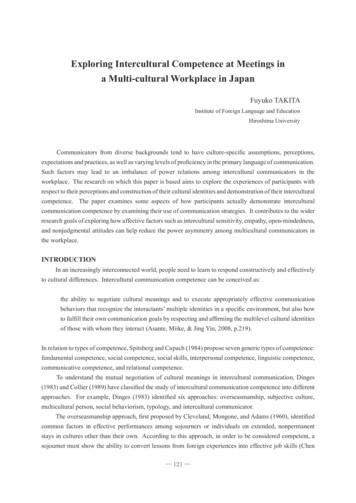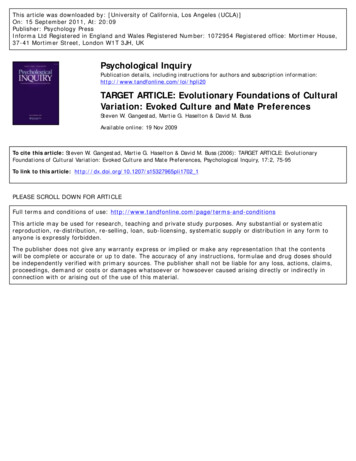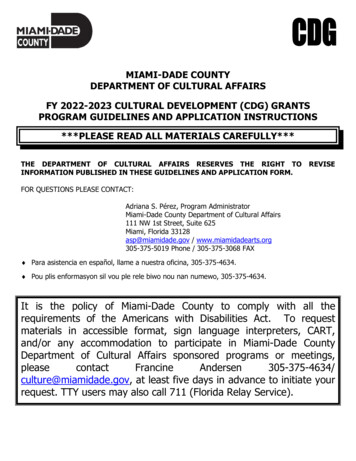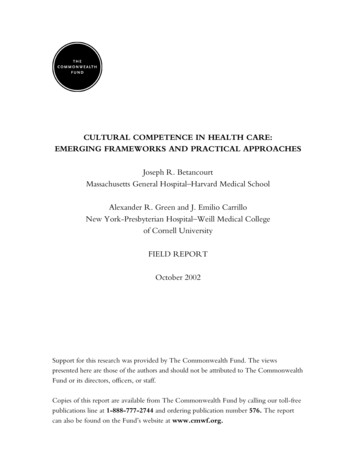
Transcription
CULTURAL COMPETENCE IN HEALTH CARE:EMERGING FRAMEWORKS AND PRACTICAL APPROACHESJoseph R. BetancourtMassachusetts General Hospital–Harvard Medical SchoolAlexander R. Green and J. Emilio CarrilloNew York-Presbyterian Hospital–Weill Medical Collegeof Cornell UniversityFIELD REPORTOctober 2002Support for this research was provided by The Commonwealth Fund. The viewspresented here are those of the authors and should not be attributed to The CommonwealthFund or its directors, officers, or staff.Copies of this report are available from The Commonwealth Fund by calling our toll-freepublications line at 1-888-777-2744 and ordering publication number 576. The reportcan also be found on the Fund’s website at www.cmwf.org.
CONTENTSAbout the Authors. ivAcknowledgments . ivExecutive Summary. vIntroduction . 1Findings. 3Defining Cultural Competence . 3Barriers to Culturally Competent Care. 3Benefits of Cultural Competence . 6Models of Culturally Competent Care . 7Academia . 7Government . 8Managed Care. 10Community Health. 12Key Components of Cultural Competence . 14Framework for Culturally Competent Care. 14Strategies for Implementation. 15Summary of Recommendations and Practical Approaches: Linking CulturalCompetence to the Elimination of Racial and Ethnic Disparities in Health Care. 17Organizational Cultural Competence . 17Systemic Cultural Competence . 17Clinical Cultural Competence. 18Appendix I. Methodology . 20Appendix II. Key Informants . 22Notes. 24LIST OF FIGURESFigure 1Demographic Projections: Growing Diversity. 1Figure 2Minorities Are Underrepresented Within Health Care Leadership . 4Figure 3Minorities Are Underrepresented Within the Health Care Workforce . 4iii
ABOUT THE AUTHORSJoseph R. Betancourt, M.D., M.P.H., is senior scientist at the Institute for HealthPolicy and program director of multicultural education at Massachusetts General Hospital–Harvard Medical School.Alexander R. Green, M.D., is assistant professor of medicine and associate director ofthe primary care residency program at New York-Presbyterian Hospital–Weill MedicalCollege of Cornell University.J. Emilio Carrillo, M.D., M.P.H., is assistant professor of medicine and public healthat Weill Medical College of Cornell University and medical director of the New YorkPresbyterian Healthcare Network.Research CoordinatorsOwusu Ananeh-Firempong II is research associate at the Institute for Health Policy,Massachusetts General Hospital.Chinwe Onyekere, M.P.H., is program associate at the Robert Wood Johnson Foundation.Research StaffElyse Park, Ph.D., is senior scientist at the Institute for Health Policy and instructor inthe department of psychiatry at Massachusetts General Hospital.Ellie MacDonald is research associate at the Institute for Health Policy, MassachusettsGeneral Hospital.ACKNOWLEDGMENTSThe authors would like to thank all of the key informants for their participation andinsights. In addition, they would like to thank those individuals who were kind enough tocoordinate and facilitate the model practice site visits.Visit www.massgeneral.org/healthpolicy/cchc.html for a more detailed report thatincludes further information about the authors, interviews with key experts, and site visits;links to websites focused on cultural competence and racial/ethnic disparities; anautosearch engine for recent literature on cultural competence and racial/ethnic disparities;a guest book; and a searchable database of models of culturally competent care.iv
EXECUTIVE SUMMARYAs the United States becomes a more racially and ethnically diverse nation, healthcare systems and providers need to respond to patients’ varied perspectives, values, andbehaviors about health and well-being. Failure to understand and manage social and culturaldifferences may have significant health consequences for minority groups in particular.The field of cultural competence has recently emerged as part of a strategy toreduce disparities in access to and quality of health care. Since this is an emerging field,efforts to define and implement the principles of cultural competence are still ongoing. Toprovide a framework for discussion and examples of practical approaches to culturalcompetence, this report set out to: Evaluate current definitions of cultural competence and identify benefits to thehealth care system by reviewing the medical literature and interviewing health careexperts in government, managed care, academia, and community health caredelivery. Identify models of culturally competent care. Determine key components of cultural competence and develop recommendationsto implement culturally competent interventions and improve the quality of healthcare.DEFINING CULTURAL COMPETENCECultural competence in health care describes the ability of systems to provide care topatients with diverse values, beliefs and behaviors, including tailoring delivery to meetpatients’ social, cultural, and linguistic needs. Experts interviewed for this study describecultural competence both as a vehicle to increase access to quality care for all patientpopulations and as a business strategy to attract new patients and market share.BARRIERS TO CULTURALLY COMPETENT CAREBarriers among patients, providers, and the U.S. health care system in general that mightaffect quality and contribute to racial/ethnic disparities in care include: Lack of diversity in health care’s leadership and workforce. Systems of care poorly designed to meet the needs of diverse patient populations. Poor communication between providers and patients of different racial, ethnic, orcultural backgrounds.v
BENEFITS OF CULTURAL COMPETENCEThe literature review revealed that few studies make the link directly between culturalcompetence and the elimination of racial/ethnic disparities in health care. Health careexperts in government, managed care, academia, and community health care, on the otherhand, make a clear connection between cultural competence, quality improvement, andthe elimination of racial/ethnic disparities.MODEL PRACTICE SITE VISITSThe authors visited an academic, government, managed care, and community health careprogram, each of which had been identified by experts interviewed in these fields as beingmodels of cultural competence. Models studied included:Academic Site Visit: White Memorial Medical Center Family PracticeResidency Program, Los Angeles, CASupport provided by the California Endowment to the White Memorial Medical CenterFamily Practice Residency Program enabled several faculty members, including a directorof behavioral sciences, a manager of cross-cultural training, and a director of research andevaluation, to devote time specifically to cultural competence training. A medicalfellowship position was also established with part-time clinical and supervisoryresponsibilities to provide a practical, clinical emphasis to the curriculum.The curriculum, which is required, begins with a month-long orientation tointroduce family medicine residents to the community. The doctors spend nearly 30 hourson issues related to cultural competence, during which time they learn about traditionalhealers and community-oriented primary care and hold small group discussions, readings,and self-reflective exercises. Throughout the year, issues related to cultural competence areintegrated into the standard teaching curriculum and codified in a manual. Residentspresent clinical cases to faculty regularly, with particular emphasis on the socioculturalperspective. In addition, a yearly faculty development retreat helps to integrate culturalcompetence into all of the teaching at White Memorial. The hospital is currently assessingthe outcomes of these interventions.Government Site Visit: Language Interpreter Services and Translations,Washington StateWashington’s Department of Social and Health Services launched its Language InterpreterServices and Translations (LIST) program in 1991, at a time when the state’s immigrantand migrant populations began to grow. LIST runs a training and certification program—the only one of its kind in Washington—for interpreters and translators. It incorporates asophisticated system of qualification, including written and oral testing and extensivevi
background checks. In addition, there is a quality control system, and the state providesreimbursement for certified or qualified interpreter or translation services for all Medicaidrecipients and other department clients who need them. Requests for translation aretypically generated by providers or the social service program staff, with eight languagesreadily available and all other languages accessible on-call. Interpreters bill costs directly toLIST and the rest of the department programs for services. The program also providesservices for translation of documents.Managed Care Site Visit: Kaiser Permanente, San Francisco, CAKaiser Permanente established a department of multicultural services that provides on-siteinterpreters for patients in all languages, with internal staffing capability in 14 differentlanguages and dialects. A Chinese interpreter call center is also available to help Chinesespeaking patients make appointments, obtain medical advice, and navigate the health caresystem. A translation unit assures that written materials and signs are translated into thenecessary languages. A cultural diversity advisory board was also established for oversightand consultation.In addition, Kaiser has developed modules of culturally targeted health caredelivery at the San Francisco facility. The multilingual Chinese module and the bilingualSpanish module provide care and services to all patients but have specific cultural andlinguistic capacity to care for Chinese and Latino patients. Both modules are multispecialtyand multidisciplinary. They include, for example, diabetes nurses, case managers, andhealth educators, with the entire staff chosen for its cultural understanding and languageproficiencies.On a national level, Kaiser Permanente has a director of linguistic and culturalprograms. The California Endowment recently awarded Kaiser a grant to assess theoutcomes of these programs and validate model programs for linguistic and culturalservices. Kaiser Permanente’s Institute for Culturally Competent Care now has six currentand future centers of excellence, each with a different mission and focus: AfricanAmerican Populations (Los Angeles), Latino Populations (Colorado), Linguistic & CulturalServices (San Francisco), Women’s Health, Members with Disabilities, and EasternEuropean Populations. Each center can be used as a model and site of distribution formaterials, such as the culturally specific provider handbook, to other Kaiser Permanenteprograms.vii
Community Health Site Visit: Sunset Park Family Health Center Network ofLutheran Medical Center, Brooklyn, NYIn the early1990s, the Sunset Park Family Health Center (SPFHC) began an effort toexpand access to care for the recent Chinese immigrants in its area. The Asian Initiativewould eventually become its first experience in creating culturally competent health care.However, the initiative was originally viewed by SPFHC leadership as an intervention incommunity-oriented primary care, an approach that was well-established in theorganization’s philosophy, mission, and history. The initiative focused at first on reducingbarriers to care—offering flexible hours of service, establishing interpretation services andtranslating signage, forming stronger links to community leadership and key resources, andtraining Chinese-educated nurses in upgraded clinical skills so they could pass statelicensing exams in English. This last effort, one that addressed the shortage of linguisticallyand culturally appropriate staff, reflects an institutional priority to recruit and hire fromwithin the community.Building on these efforts, SPFHC has made cultural competence an importantgoal, funding regular staff training programs, offering patient navigators, expanding itsrelationships with community groups, and creating an environment that celebratesdiversity (e.g., by celebrating various cultural and religious holidays, displayingmulticultural artwork, offering an array of ethnic foods, and creating prayer rooms).The Mexican Health Project is one of several recent primary care sites targeting arapidly growing immigrant community. When completed, the project will not onlyprovide an assessment of community health needs but will recommend variousinterventions for communication in clinical settings and patient education.RECOMMENDATIONSTo achieve organizational cultural competence within the health care leadership andworkforce, it is important to maximize diversity. This may be accomplished through: Establishing programs for minority health care leadership development andstrengthening existing programs. The desired result is a core of professionals whomay assume influential positions in academia, government, and private industry. Hiring and promoting minorities in the health care workforce. Involving community representatives in the health care organization’s planningand quality improvement meetings.viii
To achieve systemic cultural competence (e.g., in the structures of the health caresystem) it is essential to address such initiatives as conducting community assessments,developing mechanisms for community and patient feedback, implementing systems forpatient racial/ethnic and language preference data collection, developing quality measuresfor diverse patient populations, and ensuring culturally and linguistically appropriate healtheducation materials and health promotion and disease prevention interventions. Programsto achieve systemic cultural competence may include: Making on-site interpreter services available in health care settings with significantpopulations of limited-English-proficiency (LEP) patients. Other kinds ofinterpreter services should be used in settings with smaller LEP populations orlimited financial or human resources.a Developing health information for patients that is written at the appropriateliteracy level and is targeted to the language and cultural norms of specificpopulations. Requiring large health care purchasers to include systemic cultural competenceinterventions as part of their contracting language. Identifying and implementing federal and state reimbursement strategies forinterpreter services. Title VI legislation mandating the provision of interpreterservices in health care should be enforced and institutions held accountable forsubstandard services. Using research tools to detect medical errors due to lack of systemic culturalcompetence, including those due to language barriers. Incorporating standards for measuring systemic cultural competence into standardsused by the Joint Commission on Accreditation of Healthcare Organizations(JCAHO) and by the National Committee for Quality Assurance (NCQA). Collecting race/ethnicity and language preference data for all beneficiaries,members, and clinical encounters in programs sponsored by the federalgovernment and private organizations.b The data should be used to monitor racialand ethnic disparities in health care delivery, for reporting to the public, and forquality improvement initiatives.aThis report endorses the report by the U.S. Department of Health and Human Services report,“Clarification of Title VI of the Civil Rights Act: Policies Regarding LEP Individuals.” It may be found atwww.thomas.loc.bThis paper endorses the detailed recommendations in Ruth T. Perot and Mara Youdelman, Racial,Ethnic, and Primary Language Data Collection in the Health Care System: An Assessment of Federal Policies andPractices (New York: The Commonwealth Fund, September 2001).ix
To attain clinical cultural competence, health care providers must: (1) be made awareof the impact of social and cultural factors on health beliefs and behaviors; (2) be equippedwith the tools and skills to manage these factors appropriately through training andeducation; and (3) empower their patients to be more of an active partner in the medicalencounter. Organizations can do this through: cross-cultural training as a required, integrated component of the training andprofessional development of health care providers; quality improvement efforts that include culturally and linguistically appropriatepatient survey methods and the development of process and outcome measuresthat reflect the needs of multicultural and minority populations; and programs to educate patients on how to navigate the health care system andbecome an active participant in their care.x
CULTURAL COMPETENCE IN HEALTH CARE:EMERGING FRAMEWORKS AND PRACTICAL APPROACHESINTRODUCTIONCulture has been defined as an integrated pattern of learned beliefs and behaviorsthat can be shared among groups. It includes thoughts, styles of communicating, ways ofinteracting, views on roles and relationships, values, practices, and customs.1,2 Culture isshaped by multiple influences, including race, ethnicity, nationality, language, and gender, butit also extends to socioeconomic status, physical and mental ability, sexual orientation, andoccupation, among other factors. These influences can collectively be described as “socioculturalfactors,” which shape our values, form our belief systems, and motivate our behaviors.The 2000 United States Census confirmed that our nation’s population hasbecome more diverse than ever before, and this trend is expected to continue over thenext century (Figure 1).3 As we become a more ethnically and racially diverse nation,health care systems and providers need to reflect on and respond to patients’ variedperspectives, values, beliefs, and behaviors about health and well-being. Failure tounderstand and manage sociocultural differences may have significant health consequencesfor minority groups in particular.cFigure 1. Demographic Projections:Growing Diversity4% 1%7%White13%Black1%19%HispanicAsian/PIN Am/Ak N12%13%70%60%20302000Racial/Ethnic Compositionof the U.S. PopulationSource: U.S. Census Bureau, 2000.cThe definition of “minority group” used in this paper is consistent with that of the U.S. Office ofManagement and Budget (OMB-15 Directive) and includes African Americans, Hispanics, Asian/PacificIslanders, and Native Americans/Alaska Natives.1
A number of factors lead to disparities in health and health care among racial andethnic groups, including social determinants (e.g., low socioeconomic status or pooreducation) and lack of health insurance. Sociocultural differences among patients, healthcare providers, and the health care system, in particular, are seen by health care experts aspotential causes for disparities. These differences, which may influence providers’decision-making and interactions between patients and the health care delivery system,may include: variations in patients’ ability to recognize clinical symptoms of disease andillness, thresholds for seeking care (including the impact of racism and mistrust),expectations of care (including preferences for or against diagnostic and therapeuticprocedures), and the ability to understand the prescribed treatment.4–13The field of “cultural competence” in health care has emerged in part to addressthe factors that may contribute to racial/ethnic disparities in health care. Culturalcompetence in health care describes the ability of systems to provide care to patients withdiverse values, beliefs, and behaviors, including tailoring delivery to meet patients’ social,cultural, and linguistic needs. The ultimate goal is a health care system and workforce thatcan deliver the highest quality of care to every patient, regardless of race, ethnicity,cultural background, or English proficiency.While cultural competence is widely recognized as integral to the elimination ofdisparities in health care, efforts are still ongoing to define and implement this broadconstruct.14–17 Legislators ask, for example, what policies can foster the culturalcompetence of our health care system. Administrators want to know what we can do tomake managed care organizations or hospitals more culturally competent. Academiciansask what we should teach our health care professional students about cultural competence.Finally, providers ask how we can deliver more culturally competent care at thecommunity level.To address these questions, this report set out to: Review current definitions of cultural competence and identify benefits to healthcare, based on the medical literature and interviews with health care experts ingovernment, managed care, academia, and community health care delivery. Identify models for achieving culturally competent care. Identify key components of cultural competence and develop recommendationsfor appropriate interventions.2
FINDINGSThe literature review and interviews with experts yielded a practical definition ofcultural competence in health care, highlighted sociocultural barriers that impair culturallycompetent care, and identified the benefits of culturally competent care.DEFINING CULTURAL COMPETENCEThe literature review yielded various working definitions for cultural competence, withnearly all touching upon the need for health systems and providers to be aware of andresponsive to patients’ cultural perspectives.18–20 All experts interviewed tended to seecultural competence as a way to increase access to quality care for all patient populationsand as a business imperative to respond to diverse patient populations and attract newpatients and market share.These working definitions generally held that minorities have difficulty gettingappropriate, timely, high-quality care because of language barriers and that they may havedifferent perspectives on health, medical care, and expectations about diagnosis andtreatment. Achieving cultural competence in health care would help remove thesebarriers, supplanting the current one-size-fits-all approach with a system more responsiveto the needs of an increasingly diverse population.“Cultural competence is a set of behaviors and attitudes and a culture within the business oroperation of a system that respects and takes into account the person’s cultural background, culturalbeliefs, and their values and incorporates it into the way health care is delivered to that individual.”— Administrator, Managed Care OrganizationBARRIERS TO CULTURALLY COMPETENT CAREThe literature review and interviews identified sociocultural barriers among patients,providers, and the health care system that might affect quality and contribute to racial andethnic disparities in care.Lack of Diversity in Health Care Leadership and WorkforceMany journal articles and several key informants cited the lack of diversity in health careleadership as a potential barrier to care. Minorities make up 28 percent of the U.S.population but only 3 percent of medical school faculty, 16 percent of public healthschool faculty, and 17 percent of all city and county health officers (Figure 2).21Furthermore, fully 98 percent of senior leaders in health care management are white.22This is a major concern because minority health care professionals in general may be more3
likely to take into account sociocultural factors when organizing health care deliverysystems to meet the needs of minority populations.23Figure 2. Minorities Are UnderrepresentedWithin Health Care LeadershipPercent minority28302017161030Medical SchoolPublic Health SchoolCity/County HealthTotal MinorityFacultyFacultyOfficialsPopulationSources: Bureau of Health Professions, 1999; Yax, 1999; and Collins et al., 1999.Figure 3. Minorities Are UnderrepresentedWithin the Health Care WorkforcePercent sOptometristsNursesTotal MinorityPopulationSources: Bureau of Health Professions, 1999; Yax, 1999; and Collins et al., 1999.4
Minorities are also underrepresented in the health care workforce (Figure 3).Several studies pointed to links between the racial and ethnic diversity of the health careworkforce and health care quality. For example, studies have found that when there isracial concordance between doctor and patient—that is, when they share the same racialor ethnic background—patient satisfaction and self-rated quality of care are higher.24–26Higher satisfaction and self-rated care are, in turn, closely linked to certain health outcomes,including more effective blood pressure control.27–29 Other work has established thatminority physicians disproportionately serve minority and underserved communities.30–32“If we don’t have at the table people of color and the diverse populations we serve, you can be surethat policymaking and program design are also going to be exclusionary as well and we’re goingto continue to have disparities if we don’t start increasing diversity in the health professions.”— CEO, Public HospitalSystems of Care Poorly Designed for Diverse Patient PopulationsVarious systemic issues were raised in the literature and by the health care expertsinterviewed, including poorly constructed and complicated systems that are not responsiveto the needs of diverse patient populations.33 The issue of language discordance betweenprovider and patient was foremost.34 Systems lacking interpreter services or culturally andlinguistically appropriate health education materials lead to patient dissatisfaction, poorcomprehension and adherence, and lower-quality care, according to various studies.35–43“Our health care system is complicated for all you can just imagine trying to navigate it if youhave limited-English proficiency or a different understanding of health and health care.”— Practicing Physician and Faculty Member, Academic Health CenterPoor Cross-Cultural Communication Between Providers and PatientsExperts and articles noted that other communication barriers, apart from language barriers,lead to disparities in care.44 When health care providers fail to understand socioculturaldifferences between themselves and their patients, the communication and trust betweenthem may suffer. This in turn may lead to patient dissatisfaction, poor adherence tomedications and health promotion strategies, and poorer health outcomes.45–56 Moreover,when providers fail to take sociocultural factors into account, they may resort tostereotyping, which can affect their behavior and clinical decision-making.57“Being able to communicate with people with different social mores, different languages, differentviews, different religions—it’s a means of overcoming the barriers that have been created in thesystems and messages we’re presenting.”— Administrator, U.S. Department of Health and Human Services5
BENEFITS OF CULTURAL COMPETENCEWhile many have postulated that cultural competence will lead to a reduction in racial andethnic disparities in health care, only a few studies have found direct links betweencultural competency and health care improvement.58–62 The medical literature that doesmake an explicit connection centers on the need to address language barriers betweenproviders and patients and to train providers to care for diverse patient populations.Experts interviewed, on the other hand, drew clear links among culturalcompetence, quality improvement, and the elimination of racial or ethnic disparities incare. While acknowledging many causes for such disparities, they regarded efforts toimprove quality through greater cultural competence at multiple levels as especiallyimportant. Experts also stated that culturally competent adjustments in health care deliverywould further the quality improvement movement as a whole and should occur at thesystemic and clinical encounter levels.“What we’re talking about in terms of cultural competency is providing quality care toindividuals who in the past have not received it and when I think of quality care, that’s whatwe’re looking for for all Americans.”— A
Health care experts in government, managed care, academia, and community health care, on the other hand, make a clear connection between cultural competence, quality improvement, and the elimination of racial/ethnic disparities. MODEL PRACTICE SITE VISITS The authors visited an academic, government, managed care, and community health care




